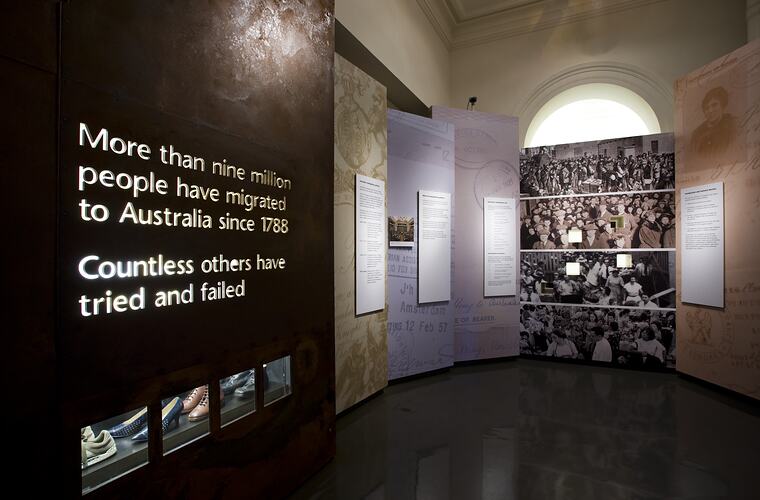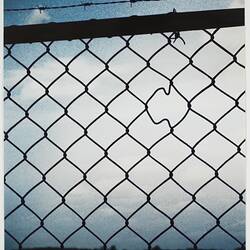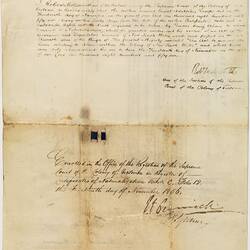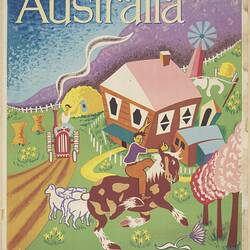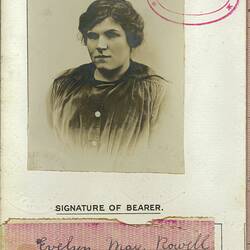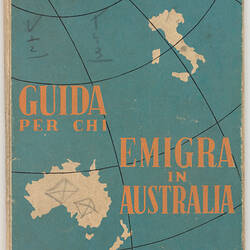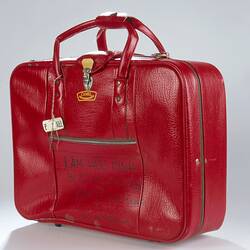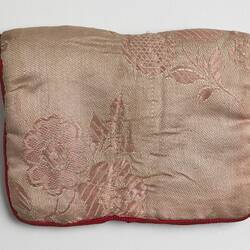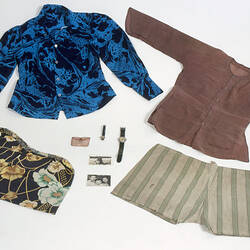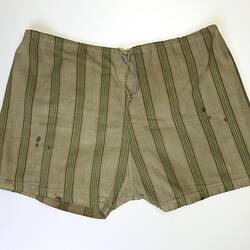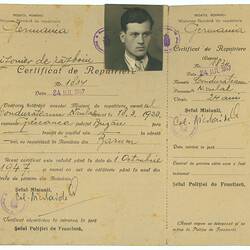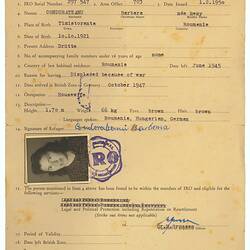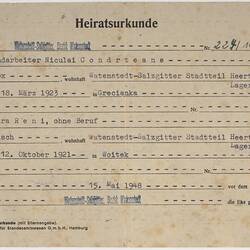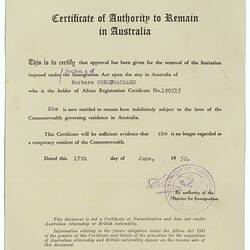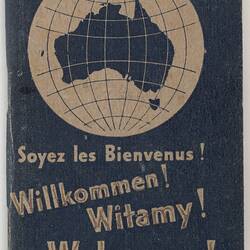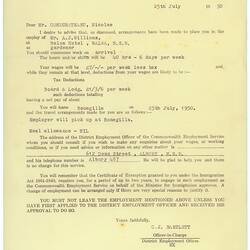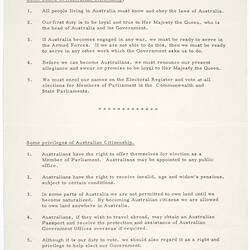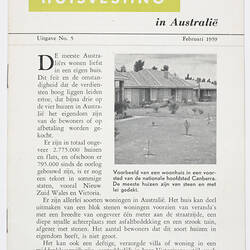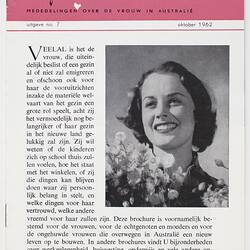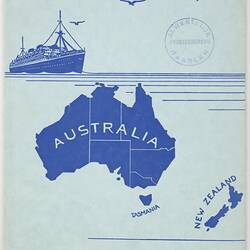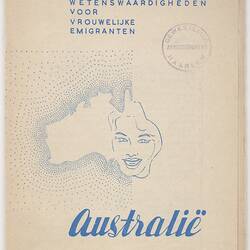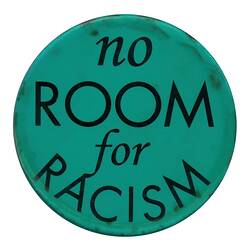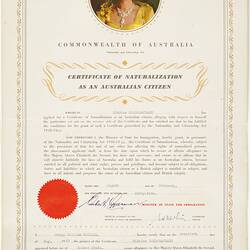Overview
Getting In focused on the policies and processes of Australian immigration across time. It was an exhibition about selection and rejection, with content presented through text, statistics, graphics, objects and compelling interactives.
Personal experiences and perspectives provide examples of particular policies. Debate and dissent about Australia's immigration policy have always been a part of the political landscape, and the exhibition brings out contrary opinions at various historical moments. It also explored the process of Australia's nation-building over time and how migrant selection has acted as a key component of the construction of a desired national identity. Objects included original immigration documents, promotional material, personal artefacts, customs items, iconographic medals, protest ephemera, all presented chronologically in four distinct time periods from the 1840s to the present day.
The broad exhibition premise was that the bottom line of Australian immigration policy over the last 200 years has been how to 'get in'. People's experiences have varied dramatically, from being welcomed, invited, assisted, accepted, discouraged and refused. Basic questions were addressed - why have some people been allowed in and others not? What rules and regulations have been created over the years to determine a person's eligibility? How have these rules changed over time? How have these changing policies both reflected and shaped public opinion?
Central to the exhibition was an interactive theatre experience whereby visitors find themselves in the role of a government official charged with the responsibility of interviewing people applying to migrate to Australia, and discovering whether or not they 'get in'. They were able to select from nine applicants over three significant periods in the development of Australia's immigration policies. Visitors who had migrated themselves were able to relate to the anxiety, anticipation, excitement and tragedy of the applicants; others gained a new understanding of what it must be like to have their lives hang in the balance and decisions taken out of their hands. In either case, the shape and development over time of Australia's immigration policies became evident as visitors witnessed the questions, responses and outcomes of the interviews and read the secondary layer of policy 'fact files'.
Further Exhibition Content
Snapshot of Australian Immigration Policy
1840-1900: The end of convict transportation and the influx of free settlers sees British policy continue to govern Australia, allowing immigration from throughout the Empire and allied countries.
1901-1945: Australia's Immigration Restriction Act, commonly known as the 'White Australia policy', restricts immigration from non-British countries.
1946-1972: Immigration policy no longer mentions race. Although British immigrants are still preferred, continental Europeans are also admitted in a push for population growth.
1973-today: Multiculturalism results in a broadening of immigration policy. People from all countries may apply to immigrate. However, overall immigration levels are reduced.
Key Themes & Immigration Policy Categories explored in Getting In
Nation Building: The question of national identity has had a profound impact on Australia's immigration policies. The idea of Australia as a white, British nation saw policies such as the Immigration Restriction Act introduced and quotas on non-British migrants, right up until the 1970s. Populating this vast continent and building industry has also impacted Australia's immigration policies and selection.
Assistance: Active selection of Australian immigrants has been helped by the provision of assisted passage immigration schemes where the Government contributed to the cost of passage and sometimes settlement. The changing focus of this assistance reflects the changing international pressures and Australian values and identity.
Rejection: As well as actively seeking particular types of immigrants Australian immigration policies have also discouraged, banned and limited the numbers of some migrants. These include the well known Immigration Restriction Act and Dictation Test which restricted Asian immigration to Australia for 70 years, to today's NUMAS system which gives applicants points in a number of categories including education, employment and wealth to assess their suitability for migration to Australia.
Family Reunion: Throughout Australian immigration history family reunions have been a means of migrating to Australia. From the Nomination and Remittance Schemes of the 19th Century to the acceptance of war brides following World War II and the use of family reunion as a key post 1970s immigration criteria.
Work: The filling of jobs has been a principal motivation of the Australian government for encouraging, accepting and rejecting immigrants. Governments have selected migrants to fill particular workforce gaps, such as today's focus on skilled migrants, and rejected migrants based on their skills and employment.
Refuge: Australia has provided a refuge for people fleeing political, cultural, religious or racial discrimination since the 19th century. The attitude of the Australian public to refugees is often contested with the management of 'off-shore' and 'on-shore' applicants currently one of the most hotly debated issues in Australian political history.
Key Objects
- Caroline Chisholm's scrapbook, known as the emigrant's friend Caroline Chisholm devoted her life to improving immigrants' lives and the conditions in which they travelled.
- 1853 cessation of convict transportation medal
- The Australian Emigrant's Manual, or a Guide to the Gold Colonies of New South Wales and Port Phillip, by John Dunmore Lang, London, 1852
- Paisley shawl worn by Isabella MacDonald for her wedding to James Abel in Aberdeen Scotland, 1851
- 2002 Anti Detention Protest Poster
- Shoe made by Bulgarian migrant and shoe maker Stanio Fancoff
- Porcelain jug produced as a souvenir of the centenary of white settlement of Australia and to commemorate the Melbourne Centennial Exhibition in 1888 - White Australia sheet music by W.E. Naunton, 1910
- Australia Today 1930 Magazine published by the United Commercial Travellers Association of Australia, 1929
- Snowy Mountains Scheme KWPR World Tunnel Record Holder Medal - Pair of blue glass vases recovered from the Loch Ard wreck
- Commemorative plate produced for Queen Victoria Golden Jubilee in 1887
Objects featured in our long term exhibitions are changed over regularly both for preservation reasons and also to maintain a diverse representation of stories, communities and cultures. Both current and past Museums Victoria objects displayed in this exhibition are listed below.
More Information
-
Keywords
Museum Victoria Exhibitions, Immigration Selection, Assisted Immigration, Immigration Policies, Immigration Debates, Immigration, Immigration Voyages, Migration & Settlement
-
Authors
-
Article types
